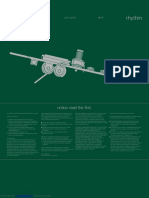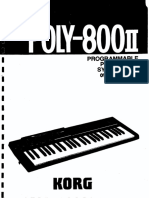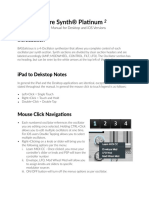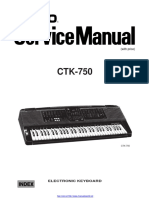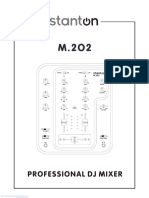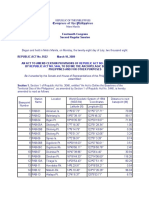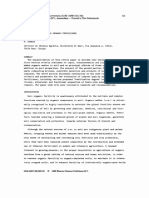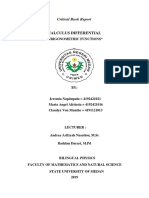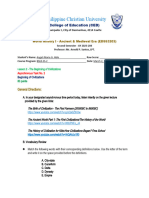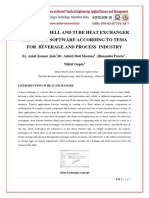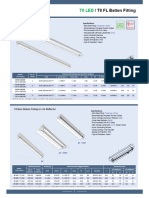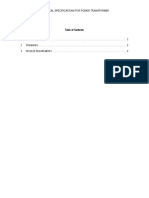User Manual
v0.9b
� GENERAL RECOMMENDATIONS
Thank you for the buying “Apparatus”, a musical tube synthesizer.
Before opening please check::
— the integrity of the packaging;
— completeness;
— correct operation of the device.
Read this manual carefully before using the synthesizer. Make sure you know the defenition of controls and
jacks for external connections.
DELIVERY SET:
— tube synthesizer “APPARATUS”;
— connector cable for connection to the power grid;
— fuse;
— kit of tubes (2x ТГ1-0.1/0.3, 2x 6Н8С, 2x6Н9С, 6Ц5С);
— kit of spare parts of tubes (ТГ1-0.1/0.3, 6Н8С, 6Н9С, 6Ц5С);
SAFETY REQUIREMENTS AND OPERATING PROCEDURES
FOR THE SYNTHESIZER
Do NOT use the synthesizer with damaged tubes! This synthesizer uses a high
voltage, which, if used improperly, can cause electric shock, and even kill you.
If you are unsure about following all the steps in this manual, do NOT use the
device. High voltage is not a joke. It is deadly to use the synthesizer under the
influence of alcohol. The lamps reach high temperatures during use, do NOT touch them
with your hands to avoid burns. Liquid spill on / into the device is inadmissible. It can
cause electric shock, damage to the device, and fire. Do NOT leave the synthesizer unat-
tended on. The Synthesizer is intended for use in an enclosed, dry environment only (at
home or in a studio). If synthesizer was at temperature below +5 °C, then keep it at room
temperature for 2-3 hours before usage. Otherwise this can cause condensation on the in-
ternal parts of the synthesizer. It can cause electric shock, damage to the device, and fire.
Do not leave the Synthesizer plugged in when it is not in use. Do not subject the Synthesizer
to sudden shocks or falls. The Synthesizer is not intended for use by children. The manu-
facturer assumes no responsibility for damage to third-party equipment resulting from
use of the Synthesizer. The manufacturer is not responsible for damage caused by failure to
observe safety precautions and operating instructions.
2
� The tube musical synthesizer “APPARATUS” is designed to operate from the AC of 120V or 230V (depending
on the region of delivery).
Put the plug out before changing a fuse.
Do Not use a self-made fuses.
Do NOT leave the synthesizer unattended on.
The synthesizer is not intended for using with humid environments and at ambient temperatures below +10°
C and above +35° C.
All controls have easy movement or strictly fixed position. Do NOT make efforts to adjust and switch them.
Protect the instrument from sharp shocks, drops, and moisture
SYNTHESIZER CONFIGURATION
The configuration and routing scheme of the synthesizer units is shown in the diagram (Fig. 5.).
The control of the tube synthesizer “Apparatus” consists of the following groups (Fig. 2.):
1. POWER
Power management. Turns on the synthesizer and indicate synthesizer power status .
2. KEYBOARD
Interface unit with external control. Receiving MIDI commands from external MIDI devices.
3. OSC MIX
Tone Generators (OSC) are the main sources of the audio signal. Mixer (MIX) mixes the signals from the tone
oscillators. You can change the pitch of the oscillators over a range of ±2 or ±12 semitones using your MIDI
controller’s pitch bend wheel.
4. FILTER
Low pass filter, controlled by voltage. Serving for tone formation. The filter can operate as a sine wave oscilla-
tor, in self-oscillation mode.
5. ENVELOPE GENERATOR
An envelope generator is used to modulate the cutoff frequency of filter and generate an amplitude envelope.
6. LFO
The low frequency oscillator is used for frequency modulation of the tone oscillators and filter with a trian-
gular or rectangular voltage. You can smoothly change the shape of the generated signal and synchronize the
frequency from the MIDI clock. You can change the depth of modulation of the oscillators freqency using your
MIDI controller’s modulation wheel. Modulation depth range is ±2 semitones for triangular waveform and +12
semitones for rectangular / sample & hold waveform.
7. AMPLIFIER
A controlled amplifier is used to express and amplitude modulate the signal from the filter output from the en-
velope generator. An amplifier overload mode is possible to enrich the spectral composition of the audio signal.
3
� Controls and indicators (Fig. 2.):
01. POWER
Power indicator. Synthesizer power-on control.
02. POWER
Switches on/off the synthesizer.
03. BENDER RANGE
MIDI Pitch Bend controller range switch. Range selectable ± 2 semitones / ± 12 semitones.
04. POLY
Mono / Duophonic mode switch.
To use the duophonic mode, move the POLY switch to the up position. Then when you press more than one
key on the MIDI keyboard, oscillator 1 will always play the highest note and oscillator 2 the lowest.
05. ACTION
Indicator for receiving MIDI commands Note On / Note Off.
06. LEARN
MIDI receive channel setup button.
To switch to another MIDI channel, you need to set the desired channel on the MIDI keyboard, then press
and hold the LEARN button, then press any key on the MIDI keyboard. Then you can release the LEARN but-
ton. The MIDI channel will be set to the desired channel.
07. VELOCITY
Adjusts the depth of the modulation of the EG amplitude versus key velocity.
08. MIX
Source selection switch. OSC1, OSC1 + OSC2, OSC2.
09. OSC1
Waveform selection for the oscillator 1.
10. OSC2
Waveform selection for the oscillator 2.
11. PORTA / LEGA
Adjusts the time and mode (legato / continuous) of the oscillator freqency from one note to another. Pull the
handle towards you to turn on the “continuous” mode.
12. TUNE
Adjusts oscillator 1 within ± 2 semitones.
13. DETUNE
Adjusts oscillator 2 within the range of 0 ..- 12 semitones.
14. OCTAVE
Oscillator 1 range select switch: 32‘ / 16’ / 8‘.
15. OCTAVE
Oscillator 1 range select switch: 32‘ / 16’ / 8‘.
4
� 16. AMOUNT OF ENVELOPE
Adjusts the depth of modulation of the filter cutoff frequency by the envelope generator.
17. CUTOFF
Sets the cutoff frequency of the filter.
18. EMPHASIS
Adjusts the filter Q-factor from minimum to self-oscillation at the filter cutoff frequency.
19. ATTACK
Sets the attack time, during which the cutoff frequency of the filter increases from the value set by the CUT-
OFF control to the value determined by the AMOUNT OF ENVELOPE control. Also sets the rise time of the
output signal amplitude from the zero level to the maximum value.
20. DECAY
Sets the decay time, during which the cutoff frequency of the filter decreases from the value established at the
end of the attack to the frequency set by the SUSTAIN control. Also sets the decay time of the output signal
amplitude from the maximum level to the level set by the SUSTAIN control
21. SUSTAIN
Sets the hold level of the filter cutoff frequency and the level of the output signal that is held while the key is
pressed.
22. RELEASE
Sets the time during which the filter cutoff frequency decreases from the value set by the SUSTAIN control to
the value selected by the CUTOFF control after releasing the keys. Also sets the time during which the ampli-
tude of the output signal decreases from the value set by the SUSTAIN control to zero after releasing the keys.
23. SINGLE / MULTI
Sets the mode to restart the EG when more than one key is pressed at the same time.
24. FREQ
Adjusts the LFO frequency and enables the LFO freqency synchronization from the MIDI clock. Pull the
control toward you to enable synchronization from the MIDI clock.
25. SHAPE
Smooth changes the shape of the triangular and rectangular signals of the LFO.
26. FORM
LFO waveform selection (square / triangle / sample & hold).
27. RETRIG / FREE
Restarting the LFO by pressing one key.
28. MOD FILTER
The depth of modulation of the cutoff frequency of the filter by the signal from the LFO.
5
� 29. MASTER
Output signal level indicator.
30. MASTER
Adjusts the output level.
31. DRIVE
Turns on and adjusts the amplifier overload level.
32. PHONES
Headphone jack.
External commutation panel (Fig. 4.):
1. EXTERNAL INPUT
External audio signal line input.
2. OUTPUT
Audio signal line output.
3. EXPRESSION PEDAL / VCF CV
Connector for a resistive expression pedal or external control voltage input for filter cutoff. The resistance of
a pedal must be at least 10 kΩ.
4. VCA CV
External control voltage input for amplifier.
5. KEYBOARD
Connector for a MIDI keyboard, or any other source of MIDI signals (MIDI controller, sequencer).
6. PC
Connector for connection to a computer.
7. Fuse holder.
Also contains a spare fuse included in the package.
8. Power connector.
Used to connect the power cord.
TECHNICAL SPECIFICATIONS
Power supply voltage is 120 / 230 volts (depending on the region of delivery).
Power consumption in not more than 40 watts.
Output voltage is not less than 1 Vp-p.
External input voltage swing is 1,6 Vp-p.
Control voltage swing is 0-10 V.
Keyboard range is 6 octaves.
Full sound range of the instrument is 10 octaves.
6
� BEFORE YOU START
To prepare your synthesizer for work you have to:
— Place the synthesizer on a stable surface;
— Install the radio tubes in the synthesizer on corresponding sockets. The position of the lamp keys is in-
dicated by arrows (Fig. 3.);
— Connect the KEYBOARD IN (Fig. 4. 3) with the output of a MIDI keyboard or sequencer;
— Connect the mains power cord (Fig. 4. 6);
— Connect the output (Fig. 4. 1) to the input of the amplifier device using an instrumental connecting cable
— Turn on (Fig. 2. 01). and warm up the synthesizer for at least 5 minutes.
— To master the synthesizeк you should study all the capabilities of the instrument at first.
WARNING:
If synthesizer was at temperature below +5 ° C, then keep it at room temperature for 2-3 hours before usage.
Tubes have a limited lifetime and are consumable items. All our tubes are new old stock and we cannot pro-
vide guarantees for them. Some can operate for at least 800 hours (minimum operating time according to a
passport), some - 20000, some can go out immediately. That’s why we complete the device with a set of spare
lamps. All lamps have been tested before shipping.
Do not leave the synthesizer on when you are not using it to extend the lamps’ lifetime.
To avoid damaging the tubes, install and remove them only by the tube base (Fig. 1).
Before removing the lamps, turn the Synthesizer off and wait for it to cool down (5 to 10 minutes).
Do not insert or remove tubes while the Synthesizer is powered on.
Fig. 1а. Correct tube installation Fig. 1а. Incorrect tube installation
7
�Fig. 2. Location of controls.
8
� Fig. 3. Installation of the tubes.
Fig. 4. External commutation panel.
9
�Fig. 5. Configuration and routing scheme of the synthesizer units.
10
� LIMITED WARRANTY
Manufacturer warrants that its products will be free from defects in materials and workmanship, and shall
conform to specifications current at the time of shipment, for a period of one year from date of purchase.
During the one-year period, any defective products will be repaired or replaced, at manufacturer option, on
a return-to-factory basis. This Warranty covers defects that manufacturer determines are no fault of the user.
RETURNING YOUR SYNTHESIZER FOR REPLACEMENT/REPAIR
You must obtain prior approval before returning any product to us. Wrap your synthesizer carefully. The
warranty will not be honored if the product is not properly packed. Send it to manufacturer with transporta-
tion and insurance charges paid. A reasonable cost for service, materials and return freight will be charged to
replace materials defective through the fault of the user, or for which the one year warranty period has expired.
Shipping products repaired or replaced under warranty from the company to your address in the Russian Fed-
eration will be paid by the manufacturer.
11










